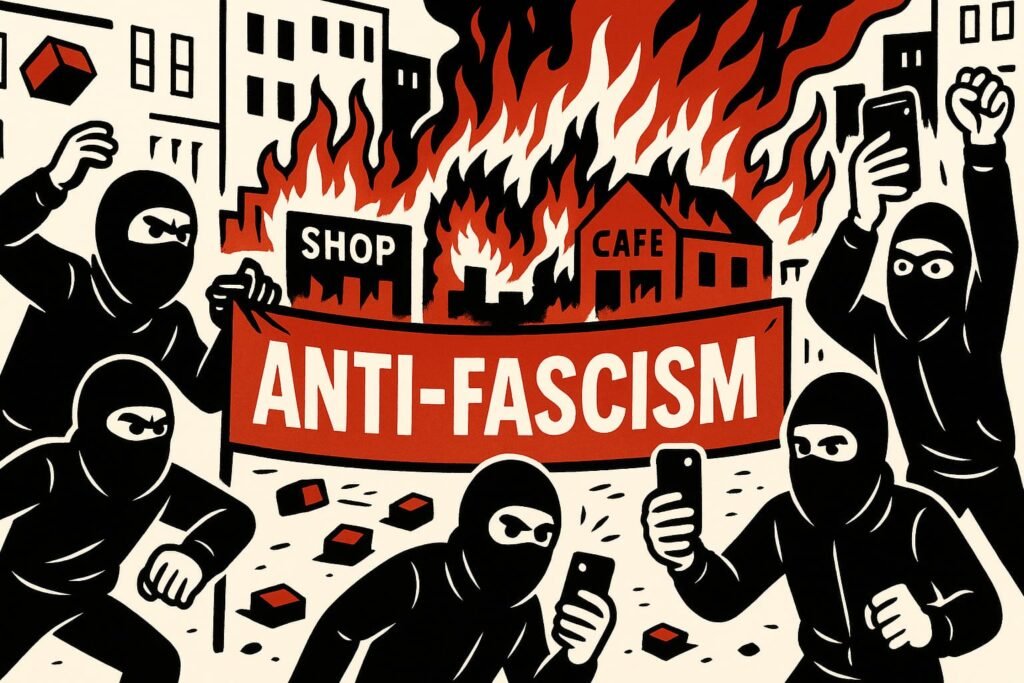Antifa Explained – From Anti-Fascism to Anarchist Chaos
From Street Fights to Cultural Leverage
“Anti-fascist” sounds noble. Who wouldn’t oppose fascism?
But behind the mask, Antifa is less about defending democracy and more about tearing it down. Born from anarchist and Marxist networks, the movement thrives on chaos: smashed windows, street brawls, and online intimidation.
Antifa is not a protest group. It’s a strategy: use violence, fear, and spectacle to shift the narrative.
Table of contents
What Is Antifa?
In plain English:
- No leaders, no structure, no accountability.
- Everything is justified as long as it’s “against fascism.”
- Fascism = anything they oppose: cops, conservatives, capitalism, free speech.
- Tactics range from online doxxing to Molotov cocktails.
The mask isn’t just literal. It’s ideological camouflage.
From Noble Cause to Industry of Chaos
Antifa borrows the language of justice but channels it into street warfare.
- The noble facade: fighting racism and fascism.
- The reality: black blocs smashing businesses, intimidating opponents, and hijacking protests like BLM for cover.
- The goal: not reform, but destabilisation.
What looks like activism is really permanent confrontation.
How Antifa Shows Up in Practice
- Politics: Disguised as grassroots protest, but really pressure on cities to defund police and normalise street violence.
- Corporations: Publicly distance themselves, but quietly benefit from the culture war distraction.
- Education: Normalisation of “anti-fascist” framing in curricula, branding critics as fascist sympathisers.
- Media: Plays the game of “mostly peaceful protests,” downplaying the arson and violence.
Antifa became the shock troops of woke politics — supplying militancy, while others supply narratives.
Buzzwords of Antifa
- No Platform → Shutting down speakers by force.
- All Cops Are Bastards (ACAB) → Police = fascists.
- By Any Means Necessary → Anything goes, no matter the cost.
- Anti-Fascism → A moral shield for anarchy.
These aren’t slogans. They’re permission slips for destruction.
The Playbook of Disruption
Antifa tactics mirror the wider far-left activist style: provoke, disrupt, dominate the narrative, then disappear. It’s less politics than performance art — with real-world collateral.
- Provocation + Victimhood → Pick fights, then frame retaliation as proof of oppression.
- Disruption as Strategy → Block roads, vandalise, glue yourself to things — outrage guarantees headlines.
- Symbolism Over Substance → Slogans and stunts replace policy.
- Hijacking Grievances → Real issues (racism, climate, inequality) inflated into existential crises.
- Censorship & Deplatforming → Cancel campaigns, doxxing, online harassment.
- The Infinite Grievance Machine → Goals always shift so the fight never ends.
- Follow the Money → Billionaires, NGOs, and “community groups” bankroll the theatre of resistance.
The Money & the Mask
Antifa isn’t a formal NGO with offices. But money still flows:
- Wealthy donors & NGOs quietly fund “community groups” linked to Antifa.
- Activist networks channel cash for bail, gear, and propaganda.
- Cover from movements like BLM provides legitimacy — and fundraising pipelines.
Decentralisation makes it slippery: no HQ, but endless streams of resources and recruits.
Who Benefited? Who Didn’t?
Winners:
- Radical activists → cover to escalate violence without full scrutiny.
- Politicians → leverage Antifa as either a scarecrow or silent ally.
- Media → endless clicks from chaos footage.
Losers:
- Communities whose businesses burned.
- Ordinary protesters who saw their cause hijacked.
- The public, forced into deeper polarisation.
The Consequences of Antifa Thinking
- Violence Normalised → Street clashes as politics by other means.
- Democracy Undermined → Free speech replaced with mob veto.
- Division Deepened → Middle ground erased; silence = complicity.
- Fuel for the Far-Right → Antifa excesses became the best recruitment tool for their supposed enemies.
Antifa claims to fight fascism, but it often strengthens it instead.
Why It Matters
Antifa shows the dark logic of modern activism:
- Take a moral cause.
- Stretch the definition of “enemy” until it includes everyone.
- Justify violence as justice.
Antifa’s role isn’t to build. It’s to burn — literally and politically. And yet, by cloaking itself in anti-fascism, it gave elites a perfect excuse: “better us than them.”
The Mask Slips
Antifa began with anti-fascist ideals. It ended as an anarchist playbook.
The mask is not just black cloth — it’s the mask of legitimacy, hiding a movement that thrives on chaos, polarisation, and fear.
👉 Want the bigger picture? Explore our full Activism Explainer Hub to see how movements, tactics, and ideologies shape modern politics.
FAQ: Antifa
What does Antifa stand for?
Short for “anti-fascist,” it’s a loosely organised anarchist network that uses militant tactics.
Why is Antifa controversial?
Because it justifies violence as “resistance,” often targeting ordinary communities.
Does Antifa have leaders?
No formal structure, but local groups like Rose City Antifa coordinate actions.
How does Antifa connect to other movements?
It often piggybacks on protests like BLM, using their legitimacy as cover for militancy.
What’s the irony of Antifa?
In fighting “fascism,” it often mirrors authoritarianism — silencing dissent, enforcing dogma, and ruling by fear.
How does Antifa operate in practice?
Through a playbook of disruption: provoke clashes, frame themselves as victims, hijack wider protests, and use stunts or violence to dominate the narrative. The tactics are designed less to persuade than to destabilise and intimidate.



